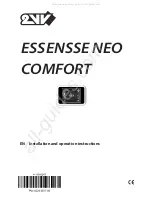
CHAPTER 28 Advanced SBC Features
Mediant 4000 SBC | User's Manual
WebRTC
The device supports interworking of Web Real-Time Communication (WebRTC) and SIP-based
VoIP communication. The device interworks WebRTC calls made from a Web browser (WebRTC
client) and the SIP destination. The device provides the media interface to WebRTC.
WebRTC is a browser-based real-time communication protocol. WebRTC is an open source,
client-side API definition (based on JavaScript) drafted by the World Wide Web Consortium (W3C)
that supports browser-to-browser applications for voice calling (video chat, and P2P file sharing)
without plugins. Currently, the device's WebRTC feature is supported only by Mozilla Firefox and
Google Chrome Web browsers other browsers are still not fully compatible with WebRTC). Though
the WebRTC standard has obvious implications for changing the nature of peer- to- peer
communication, it is also an ideal solution for customer-care solutions to allow direct access to the
contact center. An example of a WebRTC application is a click-to-call button on a consumer Web
site (see following figure). After clicking the button, the customer can start a voice and/or video call
with a customer service personnel directly from the browser without having to download any
additional software plugins. The figure below displays an example of a click-to-call application from
a customer Web page, where the client needs to enter credentials (username and password) before
placing the call.
●
The WebRTC feature is a license-based feature and is available only if it is
included in the License Key that is installed on the device. For ordering the feature
and the number of required WebRTC sessions, please contact the sales
representative of your purchased device.
●
For maximum concurrent WebRTC sessions (signaling-over-secure WebSocket
and media-over-DTLS), refer to the
.
The WebRTC standard requires the following mandatory components, which are supported by the
device:
■
Voice coders:
Narrowband G.711 and wideband Opus (Version 1.0.3, per RFC 6176).
■
Video coders:
VP8 video coder. The device transparently forwards the video stream, encoded
with the VP8 coder, between the endpoints.
■
ICE (per RFCs 5389/5245):
Resolves NAT traversal problems, using STUN and TURN
protocols to connect peers. For more information, see
.
- 604 -
Содержание Mediant 4000 SBC
Страница 1: ...User s Manual AudioCodes Series of Session Border Controllers SBC Mediant 4000 SBC Version 7 2...
Страница 40: ...Part I Getting Started with Initial Connectivity...
Страница 48: ...Part II Management Tools...
Страница 113: ...Part III General System Settings...
Страница 118: ...Part IV General VoIP Configuration...
Страница 525: ...Part V Session Border Controller Application...
Страница 654: ...Part VI Cloud Resilience Package...
Страница 663: ...Part VII High Availability System...
Страница 685: ...Part VIII Maintenance...
Страница 759: ...Part IX Status Performance Monitoring and Reporting...
Страница 844: ...Part X Diagnostics...
Страница 888: ...Part XI Appendix...
Страница 1036: ...This page is intentionally left blank CHAPTER 62 Technical Specifications Mediant 4000 SBC User s Manual 1003...
















































